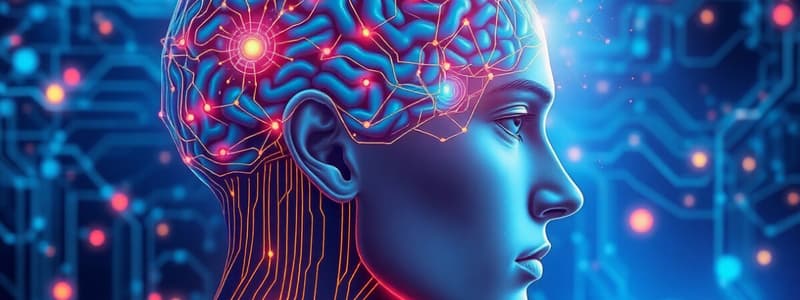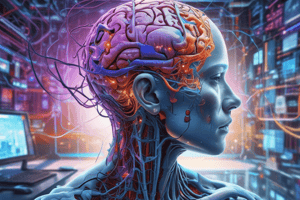Podcast
Questions and Answers
Which of the following is a critical component for ensuring the growth and effectiveness of Brain-Computer Interfaces (BCIs)?
Which of the following is a critical component for ensuring the growth and effectiveness of Brain-Computer Interfaces (BCIs)?
- Relying solely on pre-set algorithms without user-specific adjustments.
- Minimizing the adaptive capacity of the brain to maintain consistent signal interpretation.
- Designing a third level of adaptation that accommodates and engages the brain's adaptive capacity. (correct)
- Ignoring the user's intent and focusing on standardized amplitude ranges for mu-rhythm.
What distinguishes an independent Brain-Computer Interface (BCI) from a dependent BCI?
What distinguishes an independent Brain-Computer Interface (BCI) from a dependent BCI?
- Dependent BCIs are primarily used for individuals without severe neuromuscular disabilities.
- Dependent BCIs detect messages carried out in brain's normal output pathway.
- Independent BCIs always rely on the brain's normal pathways to carry messages, while dependent BCIs do not.
- Independent BCIs do not involve normal output pathways of peripheral nerves and muscles, unlike dependent BCIs. (correct)
Which of the following describes the functionality of neurons that BCI uses?
Which of the following describes the functionality of neurons that BCI uses?
- They operate independently without interconnection, dividing the brain into precisely 25 distinct local points.
- They have four basic functionalities: input, trigger, conduction, and output, utilizing electrical signals. (correct)
- They act as micro-processing stations, primarily conducting magnetic signals.
- They transmit signals uniformly, unaffected by data severity or threshold values.
In the context of BCI development, what is a major consideration regarding neuronal activity and long-term use?
In the context of BCI development, what is a major consideration regarding neuronal activity and long-term use?
Which statement accurately describes the role and function of electrodes in EEG signal acquisition for BCI?
Which statement accurately describes the role and function of electrodes in EEG signal acquisition for BCI?
Why is signal pre-processing a crucial step in non-invasive EEG acquisition for Brain-Computer Interfaces (BCIs)?
Why is signal pre-processing a crucial step in non-invasive EEG acquisition for Brain-Computer Interfaces (BCIs)?
How does Independent Component Analysis (ICA) assist in enhancing EEG signals for Brain-Computer Interfaces (BCIs)?
How does Independent Component Analysis (ICA) assist in enhancing EEG signals for Brain-Computer Interfaces (BCIs)?
Which of the following describes the role of translation algorithms in BCI systems?
Which of the following describes the role of translation algorithms in BCI systems?
What role do machine learning algorithms play in advancing brain-controlled applications within BCI?
What role do machine learning algorithms play in advancing brain-controlled applications within BCI?
Why are Microelectromechanical Systems (MEMS) being used in the fabrication of dry EEG electrodes?
Why are Microelectromechanical Systems (MEMS) being used in the fabrication of dry EEG electrodes?
Flashcards
Brain-computer interface (BCI)
Brain-computer interface (BCI)
A non-muscular channel of communication between the human brain and a computer system.
Electroencephalogram (EEG)
Electroencephalogram (EEG)
Electrical activity generated by brain structures and recorded from the scalp using electrodes.
Neurons
Neurons
Micro-processing stations interconnected; have input, trigger, conduction, and output functions.
Invasive BCI
Invasive BCI
Signup and view all the flashcards
Noninvasive Method
Noninvasive Method
Signup and view all the flashcards
Bandstop Filter
Bandstop Filter
Signup and view all the flashcards
Independent Component Analysis (ICA)
Independent Component Analysis (ICA)
Signup and view all the flashcards
Matching Pursuit Algorithm
Matching Pursuit Algorithm
Signup and view all the flashcards
Mental strategies for BCI
Mental strategies for BCI
Signup and view all the flashcards
Numerical data analysis tools
Numerical data analysis tools
Signup and view all the flashcards
Study Notes
Brain Computer Interface: A Review
- A brain-computer interface (BCI) facilitates communication between the human brain and a computer system through non-muscular channels.
- Advancements in electronics and the need to assist individuals with neuromuscular disorders have spurred the development of BCI.
- Electroencephalogram (EEG), which records electrical activity from the scalp, is used to characterize brain activity.
- EEG measures brain activity non-invasively using portable equipment.
- BCI systems translate EEG activity into commands for controlling external devices like robotic arms and wheelchairs.
- Standard BCI setups involve data acquisition, signal pre-processing, feature extraction, classification, and control interface.
Introduction
- Cognitive neuroscience and brain imaging advancements enable communication between brain activity and peripheral devices.
- BCI technology monitors and controls activity in real-time, benefiting individuals with disabilities.
- BCI assists with biofeedback training for conditions such as stroke, epilepsy, and ADHD.
- Sensors record changes in electrical potential, magnetic fields, and ion flow related to brain activity.
What is BCI?
- Brain-Computer Interface (BCI) provides a means of communication for people with movement disabilities using EEG or other brain signals.
- The brain contains over 100 billion neurons, which are studied to understand the signals they produce.
- Researchers are focusing on applications such as light/television control, text processing, and virtual reality games.
Early History
- Richard Caton first recorded EEG signals from animal cortical surfaces in 1875.
- Hans Berger discovered electrical signals from the human brain using EEG in 1929 and recorded Alpha Waves (8-10 Hz).
- Adrian and Matthew discovered that EEG signals vary across the head and suggested standardized electrode positioning.
- The USA's Defence Advanced Research Projects Agency (DARPA) started a program in the 1970s to explore EEG activity, expanding research beyond clinical diagnosis.
Advancement
- Research on BCI increased significantly after 1995 due to technological advancements.
- BCI Information Transfer Rates (ITR) improved from 5-25 bits/min to 84.7 bits/min.
- BCI advancements aim to improve the lives of 'locked-in' patients by providing means of communication.
- Research is geared towards a greater understanding of EEG and enhanced brain activity recording techniques.
- Advancements in low-cost microelectronics enable complicated tasks through embedded circuits.
- Machine learning algorithms contribute to brain-controlled applications.
Brain Computer Interface: Basic
- Neurons, the micro-processing stations in the brain, have input, trigger, conduction, and output functionalities.
- BCI uses electrical signals generated by neuron firing or inhibition.
- Neurons fire or inhibit based on whether data severity exceeds or falls below a threshold.
- The brain consists of 52 discrete points in a cytoarchitectural map.
- A neuron activates on the scalp as an electrical pulse or magnetic field during various activities.
- A BCI system converts input from the brain into real-time action.
- Key BCI phases include data acquisition, signal processing & classification, computer interface, and application.
Data Acquisition
- In BCI, signal acquisition is done using invasive, partially invasive, and non-invasive methods.
- The invasive technique involves reading brain signals from inside the brain's gray matter requiring brain surgery.
- Electrocorticography (ECOG) is a partially invasive BCI method, done by implanting a BCI device outside the grey matter.
- Noninvasive BCI is the most used method in which electrodes are mounted on the scalp.
- EEG signals are noisy compared to invasive methods.
- Non-invasive methods include Magnetoencephalography (MEG), Magnetic Resonance Imaging (MRI), Functional Magnetic Resonance Imaging (fMRI) and P-300 based BCI, and Positron Emission Tomography (PET).
- fMRI measures hemodynamic response to neural activity and is popular due to its low invasiveness, absence of radiation exposure, and wide availability.
- MEG uses superconducting quantum interface devices (SQUIDs) arrays to record magnetic fields.
- EEG is used for real-time applications because it has a short time constant and easy-to-use equipment.
- The American EEG society uses the International 10-20 system to standardize the position of the electrode for use.
- EEG signals can be acquired using wet Ag/AgCl electrodes.
- Conventional wet electrodes require preparation time, conductive gel, and may cause allergic reactions.
- Microelectromechanical Systems (MEMS) helps to design dry MEMS electrodes to acquire EEG signals.
- Recording brain activity requires mounting multiple electrodes on the scalp for 20-40 minutes per run.
- Active electrodes collect and amplify signals, and voltage drop occurs in passive electrodes.
Signal Processing and Classification
- Non-invasive EEG acquisition captures input signals, contains noise, electronics interference, electromyography (EMG) and ocular artifacts, which can lead to incorrect results.
- Signal processing enhances acquired input signals and involves time domain or frequency domain techniques.
- Bandstop filters attenuate frequencies in the range of 50 to 60 Hz, though there are some limitations.
- Useful information within the EEG lies within Theta band 4-8 Hz, Alpha-1 band 8-10 Hz, Alpha-2 band 10-20 Hz, Beta band 12-30 Hz, and Gamma band 30-100 Hz
- Bandpass filters extract specific frequency ranges.
- Noise filters adapt to the spectrum of an input signal and attenuates an input signal in frequency.
- Adaptive filtering helps the EOG or EMG has a strong correlation with measurement.
- Blind Source Separation identifies EEG sources and incorporates EOG/EMG signals into analysis.
- Independent Component Analysis (ICA) decomposes noise, assuming sources equal electrodes and no time delay.
- Centering and Whitening are major steps of ICA.
- Matching Pursuit Algorithm decomposes signals into Gabor dictionary components and can compared to algorithms by Barreto and etc.
- Recurrent quantum neural network(RQNN) can be used to filter.
Computer Interface
- Recorded EEG signals can be processed online or offline for feature extraction along with computer algorithms.
- Feature extraction from EEG signals includes amplitude or latencies of potentials, or frequencies of rhythms.
- Systems extract features and convert them into meaningful control using translation algorithms, which can be simple or complex neural networks.
- Users adapt algorithms, as well.
- EEG signals are affected by hormonal levels, environment so BCI requires adaptation.
BCI Characteristic
- BCIs are categorized as dependent or independent.
- Dependent BCIs use activity to drive the process.
- Independent BCIs rely on brain's normal output pathways.
- Independent BCIs are used for those with severe neuromuscular disability.
Skill in BCI
- BCI evolves to reflect the brain's thought process via EEG signals and helps to understand the mind.
- Electrophysiology signals change EEG rhythms and neural firing for control.
- The brain neuromuscular output channels depend on feedback.
- The brains adaptive capacity can be extended to control electrophysiological signal.
The mental strategy
- Controlling computer peripherals involves self-controlling brain cortical potential so seek the desired brain potential.
- Motor imagery triggers cortical areas similar to executing the same movement.
- Mental tasks such as concentrating on lights, flashed letters, mental arithmetic, and imaging rotational objects are appropriate for modulating signals.
Brain-Computer Interface: Challenges
- BCI development depends on signals, data acquisition, feature extraction, translation algorithms, output devices, modes, training, protocols and use groups.
- Long-term stability is questioned, if neuronal activity can function without movement.
- The users ability to use BCI varies.
- Translation algorithms convert user input into control output, depending on signal features.
- Further study is required in BCI aspects including signal preprocessing, feature extraction, translating algorithm, and user interfaces.
Tools in BCI Research
- Numerical data analysis tools such as Matlab, Octave, and Scilab are available for BCI research, as well as BioSig.
- Software provides similarities and dissimilarities in data processing methods, but BioSig helps make research efficient.
Application
- Robotics prosthetic or an exoskeleton with brain control are the applications related to mobility.
- First BCI to restore full body mobility, Walk Again Project in development.
- With direct mouse, monitor and keyboard communication BCI has potential to insert a user into virtual world.
- Emotive device is example of BCI.
- Environment control, locomotion and exercise are five potential BCI application.
- EEG analysis and machine learning techniques is used in mobile robot control.
- BCI has applications such as the assisting communication, interaction with the patients suffering from neurological disease.
- A parameter required to extract specific frequency band in autoregressive spectral analysis.
Conclusion
- This survey focused on BCI components, signal acquisition, feature identification, algorithm with tools such as GNU Octave, FreeMat, Scilab and MARLAB.
- BCI is used for physically disabled.
- BCI varies as per application and algorithms.
- EEG signals can be recorded by invasive and noninvasive methods.
- Microelectromechanical system and Nanotechnology-based invasive methods is open BCI research.
- In addition, research is done to improve smooth control.
- There is a lot of scope in the field of BCI.
- Research is in the inter-disciplinary field for neuroscientists, engineers, psychologists, and computer scientists.
Studying That Suits You
Use AI to generate personalized quizzes and flashcards to suit your learning preferences.





